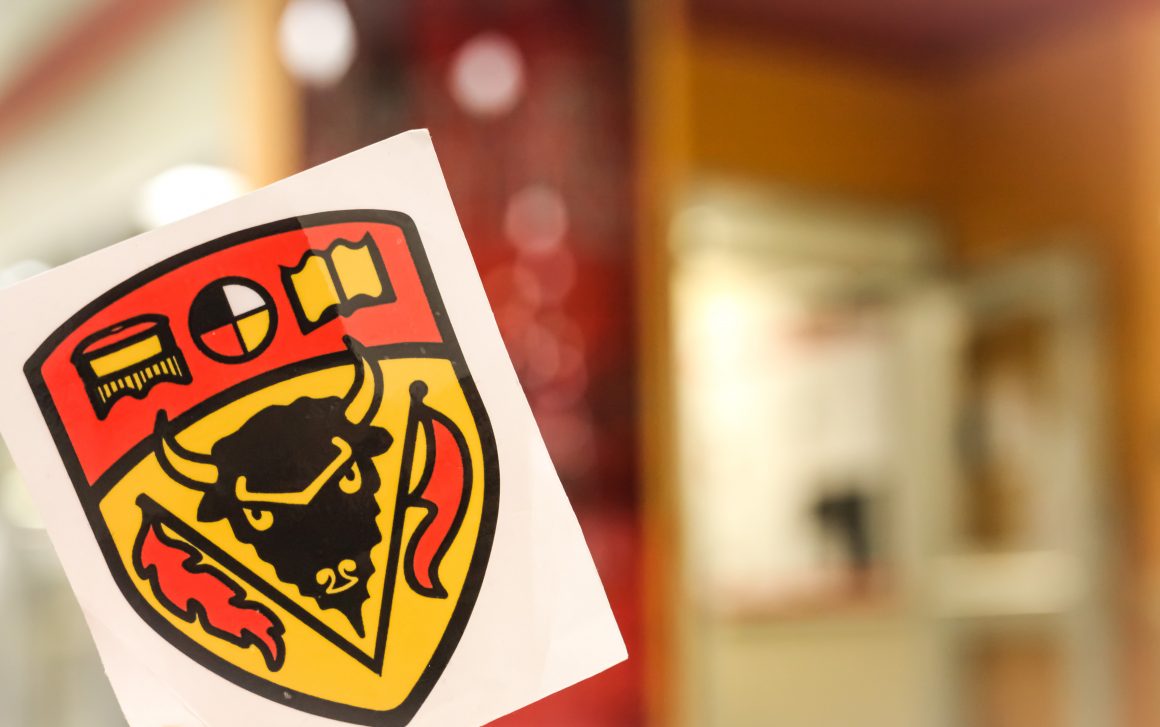
Fine arts student raises Indigenous Strategy awareness with campus-wide poster project
By Matty Hume, November 2 2017 —
You may have noticed a few new posters and stickers around campus lately. They’re familiar at first glance but are certainly a new sight upon inspection. It’s a reworked version of the U of C coat of arms — the bull is replaced by a buffalo and a flag replaced with a feather, with the Four Directions and medicine bundle also featured. The banner reads “Iinni awanii, ‘Ma’tookit! Koistomi naato,’ ” meaning “Buffalo says, ‘Take me! Your body is sacred,’ ” in English. The Indigenized U of C coat of arms is a project from master of fine arts student Nicole Tritter as part of her MFA research in Indigenization and actions of reconciliation.
Tritter says the project is intended to garner “grassroots” support for the university’s upcoming Indigenous Strategy, which was approved unanimously at the Oct. 20 U of C Board of Governors meeting.
“It was an action of reconciliation and a gesture for Indigenizing campus. I know the U of C has their own Indigenous strategy and I wanted to use this as a way to support that,” Tritter says. “We can talk about reconciliation all we like, but if there isn’t any action that is attached to it then it goes nowhere.”
With Mi’kmaq, Acadian, French and Ukrainian roots, Tritter says the first step of her research was understanding her own connection to Treaty 7 land. After taking INDG 312, a cultural immersion course taught by Reg Crowshoe and Rose Crowshoe, Tritter found the inspiration for the poster project.
Before placing the art around campus, Tritter ensured proper protocol.
“I did actually contact the Native Centre on the first day [of the posters being up] so that they understood that it was done with the correct protocol. I contacted the Crowshoes and they became my elder consults for the project,” she says. “They gifted the Blackfoot phrase that I used within the coat of arms. I gave tobacco beforehand — that’s to get the exchange of knowledge. I wanted the Native Centre to know that was done and that it was part of my MFA research.”
The Native Centre was the only party aware of the project for the first few days of the poster campaign. Tritter says she wanted to “let it sit” with the rest of campus before revealing herself and the project’s intention.
“Perhaps it was cheeky of me to put it on the door of the president’s office,” she says.
Tritter maintains that the true purpose of the project — on top of being a branch of her MFA research — is to bring awareness of the Indigenous Strategy to the campus in general.
“I wanted something that the university body could use as an idea to support the Indigenization of campus,” she says. “I wanted something for students to say, ‘Yeah, we are excited about this Indigenous Strategy and we want to show our support for it.’ ”
Tritter’s design is meant to display oral and written knowledge in equal space.
“The Four Directions in the middle, the book and the medicine bundle on the other side, that’s what creates an ethical space between them,” she says. “The medicine bundle itself has objects within it and is wrapped up. And as you bring these things out during ceremony knowledge is being shared. So I thought of all these things as chapters in a book and as you’re unfolding these items within a medicine bundle it’s kind of like a chapter.”
Tritter will present her work in the Faculty of Arts later this semester on a larger scale. Keep your eyes peeled for the unique coat of arms across campus.
